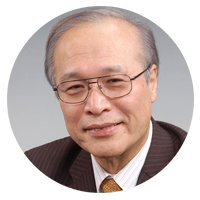Until around the end of World War II, the problem that plagued Japan was "nutrition deficiency."However, the problem rapidly changed from around the 1960s to "overnutrition."Mr. Teiji Nakamura has opened the first nutrition counseling room in Japan to study and instruct healthy diets in order to solve these two extreme problems and extend healthy life expectancy.Japan's experience should help solve the world's malnutrition problem.With that in mind, Mr. Nakamura published "Japan Nutrition," which summarizes Japan's experiences from a scientific point of view, prior to the Tokyo Nutrition Summit 2021.

The Tokyo Nutrition Summit 2021 will be held from December 12th to 7th in conjunction with the Tokyo Olympic and Paralympic Games. The "Nutrition Summit" was held in 8 by then-Prime Minister of the United Kingdom David Cameron with the aim of taking advantage of the opportunity to host the Olympic Games to promote international efforts to solve the global malnutrition problem. It begins with hosting the "Summit".So far, hunger and undernutrition have been mainly discussed, but in 2012, the "double load of malnutrition" including overnutrition will also be discussed.
"It makes sense to hold this summit in Japan," said Teiji Nakamura, president of Kanagawa University of Health Services and chairman of the Japan Dietetic Association.Japan is one of the longest-lived countries in the world, but in just over a decade from the end of the war to the period of high economic miracle, it experienced nutritional deficiencies and excessive "double load". "If the economy becomes richer, nutritional problems will become more diverse and complex," said Nakamura, who struggles at the forefront of clinical practice at the very turning point and reflects the importance of nutritional management in national policy. A person who has worked hard for this.
Even in countries that are currently suffering from hunger, diseases associated with overnutrition will become a problem as they develop.Japan's experience and the path to overcoming it should help those countries.With that in mind, Mr. Nakamura said "Japan Nutrition" prior to this summit.1(First Publishing) was published in August 2020.Also, in November 8, the English version of "Japan Nutrition" will be released to the whole world.2(Springer) was published in open access format.

This time, the magazine, which had the opportunity to interview Mr. Nakamura, asked how Japan overcame the problem of malnutrition and how Japan can contribute to the world with this experience.
――First of all, please tell us what kind of discipline you specialize in clinical nutrition.
Nakamura:Clinical nutrition is the field of research and education on diets and nutritional therapies for the prevention and treatment of diseases and disorders.Not only thinking about what kind of nutrition and diet should be taken to prevent the onset of illness, but also nutrition for dealing with loss of appetite, eating disorders, digestive / absorption disorders, metabolic disorders, etc. due to illness or disorder.・ Study diet and practice it clinically.
――Please tell us how you got on your current path.
Nakamura:When I was a high school student, I heard from a lecturer at a medical university that "a doctor who creates a society that does not get sick is better than a doctor who treats illness."I was impressed by this and became interested in preventive medicine.
After that, I entered the Department of Nutrition, Faculty of Medicine, The University of Tokushima, and started researching vitamin B6 deficiency in my graduation research.The bred rat suffered from a disease called fatty liver due to a deficiency of only one nutrient and eventually died.At this time, I thought that this important fact should be widely known to people, so I chose the path of practical nutritional activities.However, the nutritional problem at that time was nutritional deficiency due to food shortages, so it was mainly food nutrition in agriculture, food science, and cooking.
As the economy developed and the food shortage was resolved, the Japanese diet became westernized.As a result, prevention of non-communicable diseases such as obesity, diabetes and cardiovascular disease has become an important issue.
The risk of developing such a disease is not in food, but in human metabolic disorders.Therefore, it has come to be considered that improving and managing the nutritional status of human beings is more important than "nutrition management" that considers proper menus.Therefore, it was necessary to systematize human-centered nutrition with the goal of evaluating and judging human nutritional status and improving and managing human nutritional status through dietary and nutritional interventions.This is called "human nutrition".
The first professor was Professor Emeritus Norimasa Hosoya of the University of Tokyo School of Medicine.When I started nutritional guidance in clinical practice, it was a turning point from food nutrition in the era of nutritional deficiency to human nutrition required in the era of overnutrition.At the forefront of this, I decided to research and develop practical methods of human nutrition in clinical practice.
"Malnutrition" that never goes away
――How has nutritional guidance changed?
Nakamura:When I started working in the hospital, I was generally still undernourished.Nutritional guidance focused on the dissemination and enlightenment activities of foods and meals with high nutritional value and good digestion and absorption.In short, nutritional improvement was treated as a public health issue for the population.However, nutritional status has become complicated due to the rich economy and diversified diet.It became necessary to provide individualized guidance that was close to the individual's health / illness status, nutritional status, and mental and physical condition.
Malnutrition used to mean nutritional deficiency due to insufficient food intake, but now it also includes obesity due to excessive intake and the accompanying metabolic disorders.If the economy becomes rich, some of the undernutrition will be resolved, but it will be possible to eat anything anytime, anywhere, causing overnutrition.Also, in this situation, it promotes an "unbalanced diet" in which you eat only what you like, and you are more likely to have a protein, vitamin, and mineral deficiency.In addition, undernutrition due to a radical diet and health problems due to a large intake of healthy foods have come to be seen.
Therefore, I decided to open the nutrition counseling room for the first time in Japan and provide nutritional guidance using counseling techniques.The government evaluated this work and positioned it as a "nutrition dietary guidance fee" in the universal health insurance system.At first it was a small amount, but the instruction fee is now 2600 yen / 30 minutes.
――How did you overcome the double burden of malnutrition and become a country of longevity?
Nakamura:The reason for improving nutrition of Japanese people goes back about 150 years.The Meiji government introduced Western studies for the purpose of modernizing the nation, and nutrition was introduced along with medicine and agriculture.At that time, the Japanese government was thinking of using nutrition to create strong people and soldiers under the banner of "rich country strong soldiers".With the introduction of highly nutritious Western food, the nutritional status was improving.
However, the food situation deteriorated due to the long war.In 1945, at the end of World War II, there was a serious starvation.Japan's nutritional status at that time may have been more serious than in the regions of Asia and Africa that are currently starving due to civil war and climate change.So to speak, I started from scratch, but in just over 10 years I was able to solve the problem and create a healthy diet as it is today.
The achievement of this is the so-called "Japan Nutrition," a nutritional initiative unique to Japan.There are three points.
- The Japanese experienced the fear of hunger and malnutrition due to old eating habits, natural disasters, and even wars, and knew early on how important nutrition improvement was to the people and the nation.Since I knew the importance of nutrition policy, the Ministry of Health, Labor and Welfare (now the Ministry of Health, Labor and Welfare) had a nutrition section, and the "Nutrition Improvement Law" was established, and administrative guidance-type nutrition improvement based on scientific evidence was implemented as a national policy. I did.
- In order to actually proceed as a national policy, we have trained nutrition professions like no other country.Then, we placed registered dietitians and dietitians in group feeding facilities such as government agencies, schools, hospitals, companies, welfare facilities, and the Self-Defense Forces, and created a society where people can access healthy diet and nutrition education wherever they eat.After that, we trained not only nutritionists but also various nutrition-related people such as nutrition researchers, nutrition educators, and dietary improvement promotion extension workers.
- With the advancement of agricultural technology and the modernization of the food industry, many technology developers and founders of companies had a strong desire to make nutritious foods and make the people healthy.
In other words, improving nutrition in Japan was a comprehensive big project undertaken by the "industry-government-academia collaboration" that has been called for in recent years.
From Japan to the world
--"Japan Nutrition" (first publication) to coincide with the Tokyo Nutrition Summit1Was written and published.What made you look at the world's hunger problem?
Nakamura:From a young age, I have had the opportunity to attend international conferences and conferences and have seen the nutrition and diet of people from different countries.People in poor, developing or developed countries have significant differences in nutrition, diet and health.However, I cannot decide where I will be born, and I cannot do anything with my own efforts.I wanted to contribute as much as possible to the resolution of this absurdity.This is the starting point of why I work on international contributions.This hasn't changed.
The specific motivation for writing is that in recent years, experts from around the world have come to argue that "eradication of malnutrition is the basis for achieving the goals of the SDGs."Nowadays, many countries and international organizations have set up nutrition improvement plans and goals, and "nutrition" is getting more attention than I have ever experienced.However, the results were not as good as I expected, and on the contrary, it was worsened by the Corona disaster.In order to overcome this situation, I think it is necessary to disseminate "Japanese nutrition" that has the experience of overcoming this problem to the world.
It is widely known internationally that the current Japanese diet is nutritionally superior and healthy, and that it is the driving force behind maintaining the world's healthiest and longest-lived country.However, there are few papers that explain the reason scientifically, and most of them are analysis of nutrients, foods, and diets, and the conclusion is that foods that have existed uniquely in Japan for a long time and are generalized. Many say that the food is excellent.However, neither the Japanese originally consumed healthy foods, nor did Japanese traditionally have a healthy diet.Before the Meiji era, the average life expectancy was as short as about 50 years old.
With the exception of wealthy aristocrats and samurai, the traditional diet of the majority of Japanese people was a "staple-heavy" diet, with salty vegetables and fish dishes, and a large meal of rice.Suffering from protein, lipid, vitamin and mineral deficiencies, he died of infectious diseases such as tuberculosis because he was poorly grown, weak, had a high incidence of stroke and stomach cancer, and had weak resistance.
In other words, the healthy diet of the Japanese people today was not originally present, but was obtained as a result of nutrition and dietary improvement based on nutrition. I was preparing to write this book, thinking that it is important for human beings suffering from malnutrition to scientifically explain "How has Japan created a healthy diet?" ..
--After that, the English version of "Japan Nutrition"2Was published in open access format.
Nakamura:This book describes why Japan, which suffered from hunger like Asia and Africa today, succeeded in sustainable nutrition improvement and created the healthiest diet in the world.I wanted it to be read by nutritionists around the world.
International assistance is centered on food and economic assistance, and once that assistance is over, the nutritional policies of the target countries will end and disappear before you know it.The current international nutritional support does not lead to a nutritional improvement campaign aimed at "living a healthy and happy life for the rest of your life" and will not develop.Solving nutrition problems requires not only nutrition, but also knowledge and skills in a wide variety of disciplines such as agriculture, medicine, home economics, political science, sociology, and environmental science.It requires the participation of many people, including experts, professionals, politicians, and volunteers.For that reason, I wanted many people to read this book, so I made it free to read.In particular, I hope it will be a must-read for students who are thinking of studying nutrition.
When publishing the English version, I used Springer Nature's Japanese-English automatic translation service (Note 1).It was lighter and more convenient than translating it into English from the beginning as before, but it is a difficult element for automatic translation because of the social, cultural, and psychological languages and concepts in this book. It is certain that there was.
――In your book, you mentioned that it is meaningful for the Tokyo Nutrition Summit to be held in Japan.
Nakamura:The biggest challenge of the nutrition summit is "sustainable development by eradicating malnutrition", eliminating inedible and overeating people from the earth and creating a healthy and happy society without leaving anyone behind. That is.To that end, in addition to providing economic and food assistance in cooperation with each country, we will support human resource development and institutional design to make the seeds bloom, and the countries receiving support will be independent of sustainable nutrition improvement. You need to be able to do it.I think that the need for such support from both hardware and software should be shared at this summit.In addition, in order to develop a comprehensive nutrition policy, it is necessary to cooperate and collaborate with related authorities and departments, and I think that how to manage the organization will be an issue in each country.At that time, I think that Japan's experience will be helpful for many countries suffering from malnutrition.
Also, at the summit, "commitment" is required.Many organizations and institutions, including governments, academic societies, associations, foundations, companies and NGOs, are internationally committed to helping eradicate malnutrition.I think it is significant to make such a promise in Japan, which has succeeded in postwar reconstruction based on nutritional improvement.
Then I think this summit shouldn't just end with a festival, but a legacy.After the summit, there is a high possibility that some countries will want to introduce and learn Japanese nutrition.Isn't it a good idea to create a department to serve as a receiver?
The importance of professionals publishing books
――This time, the knowledge was summarized as a book.
Nakamura:In the past, experts, whether natural scientists or sociologists, were cultural figures and had a great influence on society, politics, and public opinion formation.Researchers and scientists should not only write scientific papers, but also disseminate their ideas, philosophies and ideas to society, and publishing books is an effective way to do so.In addition, it is of great significance for publishers to support them.
I think that current researchers have fallen into the principle of scientific journals because their research achievements are pointed out.It is also a pity that social contribution is considered to be the commercialization of one's research results.
The general public does not evaluate only the individual research results of experts such as researchers, but tries to believe in the high level of insight that experts have.If something like this new coronavirus pandemic happened, people would have gone to shrines and temples and prayed to God and Buddha before.But modern people have listened to the voices of scientists and experts.Experts need to live up to their expectations, and I think they should share their high level of insight and experience with people in an easy-to-understand manner through publishing.
――Finally, could you give us some advice on how young researchers should pave the way?
Nakamura:It is important to immerse yourself in your research theme.However, aiming only for that cannot be a so-called great researcher.Current research is difficult to achieve valued results without the gathering of different people and research funding.I think it is necessary to interact with people from other fields on a daily basis and to value human relationships.
Research also requires the emergence of ridiculous ideas, like the voice of God.To that end, I think it is important to familiarize yourself with art, culture, sports, etc. and improve your sensibility.
-- thank you.
(Interviewer: Editorial department)

Profile
Teiji Nakamura (Nakamura Teiji)
Clinical nutritionist.President of Kanagawa University of Health Services, Chairman of The Japan Dietetic Association
He comprehensively directs and supervises health, medical care, welfare research, education, and community contribution, which are important issues for an aging society.In addition, as the chairman of the Japan Dietetic Association and the chairman of the Japan Society for Nutrition Education, he is taking a leading position in the ideal and practical methods of nutrition.
Springer Nature offers a free automatic translation service for publishing manuscripts written in your native language in English. "Japan Nutrition" is Springer Nature's first book translated from Japanese to English by this automatic translation service.
In the automatic translation service, the original manuscript is translated into English using our own translation software based on the machine translation program "DeepL".After that, it will be published after proofreading by the author and our company.
For details, see our press release (go.nature.com/JPNutri_PR)please look at.
References
- "Japan Nutrition Unraveled by Teiji Nakamura, a Clinical Nutritionist" (First Publishing) ISBN 9784804114187
- Japan Nutrition (Springer Nature) ISBN 978-981-16-6316-1
* This article is reprinted from "Nature Digest".
Reprinted from: Nature Digest 2021 No. 12
"Bringing "Japanese nutrition" to the world at the Tokyo Nutrition Summit 2021!'
Nature Digest Vol. 18 No. 12 | doi: 10.1038 / ndigest.2021.211226
